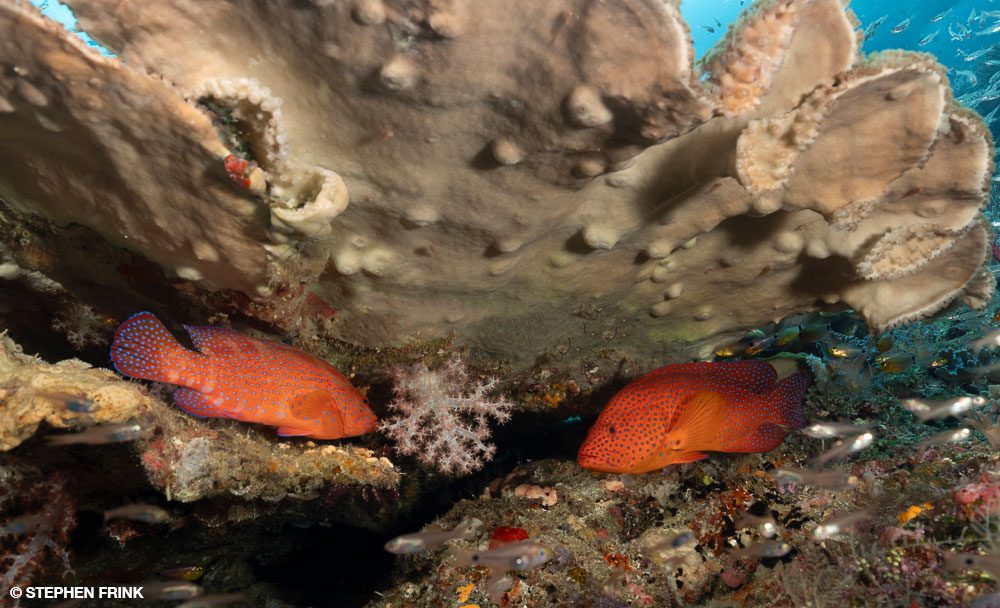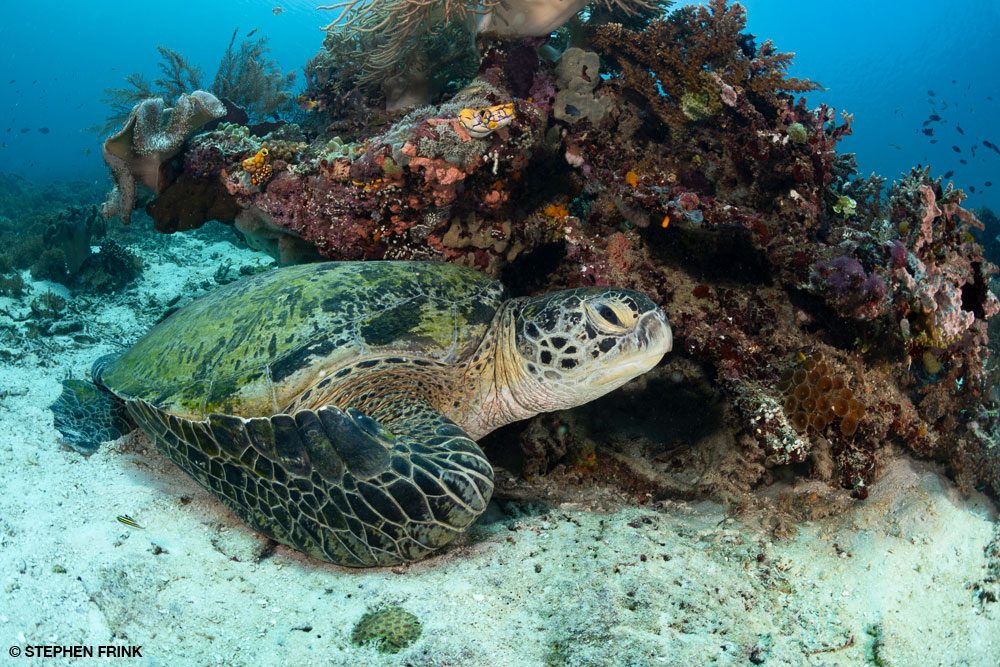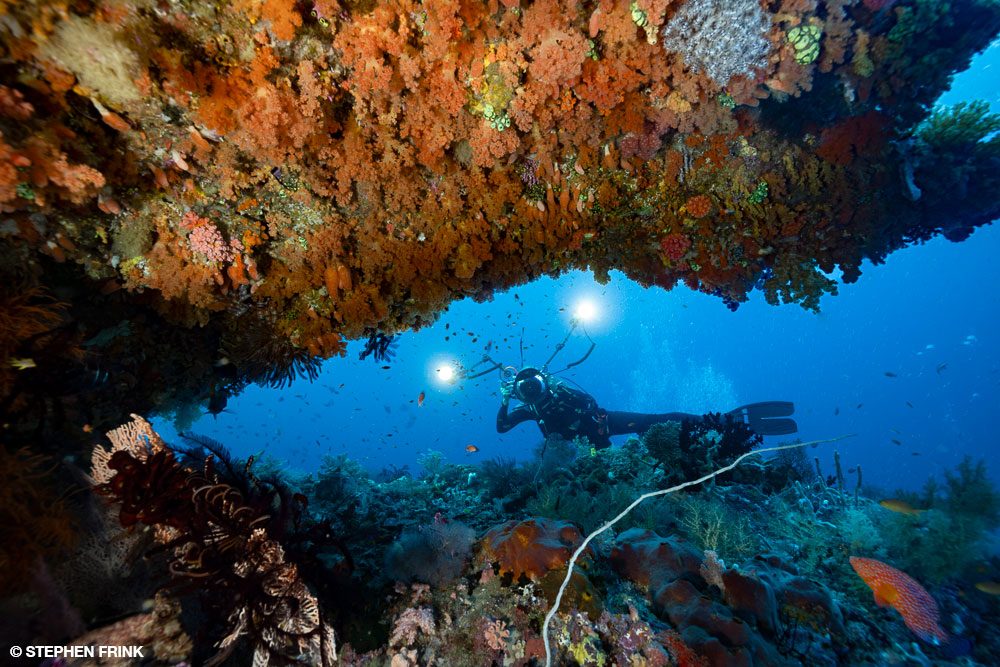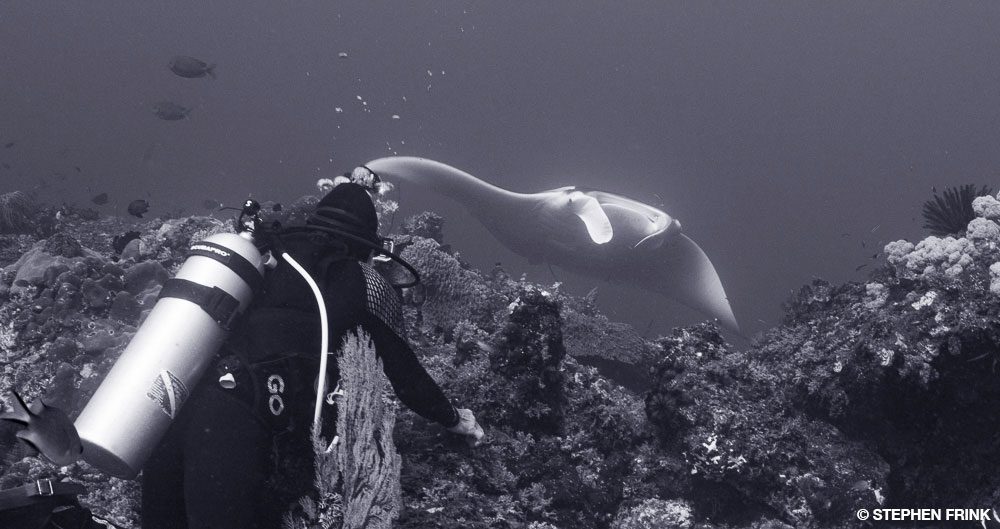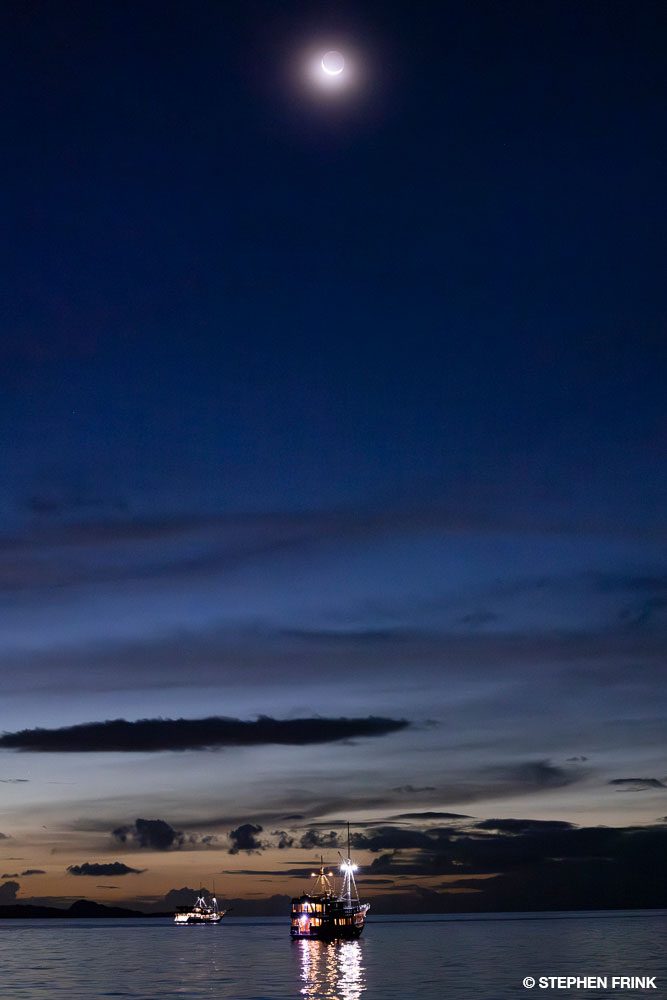Empowering Conservation Through Local Engagement
The spectacular ecosystem of Indonesia’s Raja Ampat offers ample opportunities for fish portraits and macro shots with a 100mm lens, but the broad expanses of pristine hard corals punctuated with colorful soft corals and sea fans made it difficult for me to forego using my wide-angle lens during a recent liveaboard trip.
Seeing reefs this healthy — especially after the bleaching in the Florida Keys and the Caribbean last summer — kept me shooting with my 15-35mm lens, but I frequently found vibrant reef dwellers, such as coral groupers or clown triggerfish, that I also wanted to photograph. Even at 35mm, I couldn’t get close enough for the fish portrait I imagined before they would dart away.
On one morning dive, however, the fish were much easier to approach. Wondering if this change in behavior was due to the time of day or the tides, I asked our cruise director what was different from the previous day. He said we had just entered the Misool Marine Reserve, where the fish were friendly.
Suddenly, it all made sense. I have dived marine protected areas (MPAs) off my home waters in Key Largo, Florida, for more than four decades and have learned that fish behave differently if they do not associate divers with spears or fear for their lives because of hook or net.
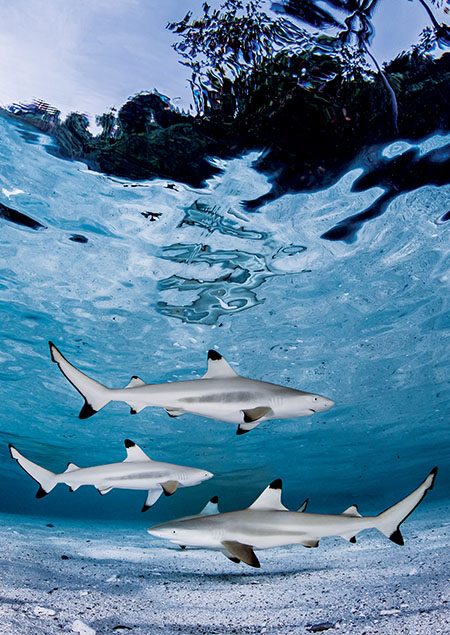
Established in 2011 as the registered nonprofit extension of Misool Resort, Misool Foundation employs a team of 49 people, including 18 full-time, salaried rangers stationed at three dedicated ranger stations to protect a 300,000-acre privately funded marine preserve. A blue-water corridor connects two distinct no-take zones and is likewise protected from destructive fishing, including nets and longlines.
The foundation is actively engaged in reef restoration, and they have a program to rewild zebra sharks and giant clams. Accomplishing all this in such a remote region must have been challenging. Eager to know the backstory, I interviewed Marit Miners, one of the founders.
How did all this start?
Miners:I was on track for a master’s degree in physical anthropology but got derailed in 2000, when I discovered diving in Thailand. It was much more interesting than studying dead things. My open-water instructor became a dear friend, and for five years she tried to set me up with her colleague, Andrew. On my 28th birthday in 2005, we finally bumped into each other in Bangkok, where Andrew was on holiday. My instructor was right: Andrew and I hit it off immediately. At the time, he was working on one of the two liveaboards in Raja Ampat. For our third date, he invited me to join him on a dive trip.


In 2005 Raja Ampat was incredibly remote, and Sorong was little more than an airstrip and a port. What made you want to stay beyond your two-week cruise?
We were young and in love, but I also had an epiphany. One day during a surface interval, we took a dinghy to a remote island called Batbitim in Misool. An itinerant shark-finning camp was there, and the detritus of the slaughter remained. In that moment, the chain of commerce became clear, linking Raja Ampat’s reefs to the shark-fin soup restaurants that were ubiquitous in Bangkok.
We had seen beautiful reefs during that month of diving but not one shark. While we were surveying the island, Andrew shared a loose idea for building a conservation center there, with some simple accommodations to fund our work.
This arrangement made us unique from the beginning: Many businesses add a conservation component once they become profitable, but we did it the other way around, with conservation as our starting point. Marine protection is integral to our ethos and business plan, with healthy reefs as our most important asset.
Andrew approached the local community, which holds the traditional rights to the area, and reached an agreement to lease several islands and the surrounding waters, which effectively evicted the shark-finners. Misool Resort now stands on the beach where they once had their camp.


Was it hard to get the local community to embrace your vision?
They already practiced a form of Indigenous fisheries management called sasi, a tradition of opening and closing areas to extraction. Leasing their waters wasn’t unusual either, albeit to shark-finners who took anything they wanted from the surrounding waters for one month for the equivalent of $30. Our ideas weren’t completely outrageous and clearly resonated with them. We wanted to create job opportunities in sustainable tourism and help protect their waters, and they knew from sasi that their catch would increase outside the no-take zone.
We had figured out the general scope of a conservation initiative linked to a resort dive operation by June 2006. We scraped together about $20,000, assembled a skeleton crew, and showed up on the island with a generator, some tools, a satellite phone, and a lot of noodles. The village appointed an elder as our first employee, who recruited others. We bought a portable sawmill and began milling reclaimed wood from tropical hardwoods that washed up on our southern beach. A nearby island had fresh water for drinking, cooking, and mixing concrete.
Shark-finners and illegal longline fishers still plagued the area even though we had a lease agreement. After a long day of construction work, our local staff would approach poachers, pelt them with pebbles, and confiscate their gear. We bought our first dedicated ranger boat with a donation from WildAid Canada.


As infrastructure expenses ramped up exponentially, the numbers weren’t working for our simple backpacker resort — we needed to go more upscale. When we opened in 2008, we had eight water cottages that catered to die-hard divers. The resort has continued to evolve, and we now welcome all kinds of adventurers.
From the start, we have had a symbiotic relationship between conservation and tourism. Biodiversity is our main asset. Our guests experience off-the-charts biodiversity thanks to Misool Foundation’s conservation initiatives, especially the efforts of our rangers, who protect the Misool Marine Reserve every day. The foundation could not exist without Misool Resort, which provides the logistical nerve center that is critical in such a remote location. The resort, in turn, is the foundation’s most consistent supporter, donating more than $200,000 in 2023.
When we were diving in the Misool Marine Reserve, the boat crew radioed the resort at 5 p.m. each day to schedule dive permissions for the next day. Is it a big task to control dive density on your local reefs?
Absolutely! We have many sites available only to our guests, but many other sites within the reserve are available to the 20 to 30 liveaboards that might be around at any time, all wanting four dives per day. We provide the service to optimize everyone’s experience while managing the impact on the reefs. Most operators understand and see it as an asset to their guests’ experience as well as a conservation imperative.
South Raja Ampat is not a year-round destination. How do you manage patrols when the divers aren’t there?
The resort is open only from mid-September to mid-June, but the rangers are there 24/7, year-round, even in the worst monsoon conditions. Our resort team does maintenance work in the off-season. Conservation is a full-time job of protecting what’s there and rewilding where we can.
With our Reef Restoration Project, for example, we plant different types of coral, but we don’t have a coral nursery. We collect fragments in the wild that have broken naturally but are still living. Our water quality is such that corals will thrive if given a chance. We target rubble zones from past dynamite fishing for restoration. Our jetty was one of those rubble areas — we didn’t want construction to damage a natural reef. We have been planting coral there since 2013, and it is now a flourishing reef.
Giant clams (Tridacna spp.) are another example. Over 60,000 years the island has likely never had a permanent settlement because no freshwater source exists. Giant clams are an easy meal, but they don’t return so easily once they are gone. They broadcast spawn, so they must be near each other to reproduce. Moving a giant clam close to another is a monumental task, but we’re making progress with our clam garden.
Many shark species now thrive in our area thanks to our ranger patrol’s vigilance. Due to the high level of protection, ReShark chose Misool Foundation as a nursery and hatchery site. The international collective has a groundbreaking initiative to rewild endangered zebra sharks (Stegostoma tigrinum, also called leopard sharks in some regions). These sharks are now functionally extinct in Raja Ampat and won’t come back in our lifetime without human intervention. Jennifer Hayes and David Doubilet were recently here to document ReShark for National Geographic.

Aquariums worldwide are collaborating to breed zebra shark eggs, called mermaid’s purses, which are then transported to local hatcheries. Shark nannies tend to them after hatching until the pups are large enough to be tagged and released into the wild. The project’s goal is to release 500 zebra sharks in Raja Ampat, establishing a healthy, genetically diverse, and self-sustaining population.
That’s an impressive effort, and the increasing biodiversity in your waters is inspirational. Through social media I knew that Alex Mustard was teaching a photo class at Misool Resort while I was writing this article. I asked his opinion of the diving, and his response was consensual validation:
“I first dived Misool in 2006, before the resort was there, and the reefs were the most spectacular I’d ever seen, with wonderful coral and abundant fish. The diving is even better on the two trips I’ve already made in 2024. There are more divers but also a lot more fish, turtles, rays, and sharks. Every dive had reef sharks, with hammerheads, threshers, and even tigers from time to time. Species we usually witness disappearing from oceans are blossoming here. There’s no magic; it’s sound marine conservation and lots of effort. People who put in the very hard work to make ideas a reality are sadly vanishingly rare. And our planet needs more of them.”
For more information about the ReShark project, visit https://tinyurl.com/reshark. For more information on rewilding, see www.tinyurl.com/rewild-misool.
Explore More
See more of Misool in this photo gallery.
© Alert Diver — Q2 2024

